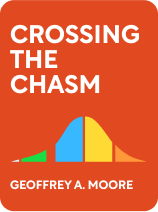

This article is an excerpt from the Shortform book guide to "Crossing the Chasm" by Geoffrey Moore. Shortform has the world's best summaries and analyses of books you should be reading.
Like this article? Sign up for a free trial here .
How do you market a breakthrough technology? What customer segments should you target?
According to Geoffrey Moore, the author of Crossing the Chasm, marketing high-tech products to the early market begins with innovators and moves to early adopters, early majority, late majority, and then laggards. The challenge for companies is to cross the chasm between the early market and the mainstream market (where the majority of customers are) and ultimately accelerate adoption across every segment.
In this article, we’ll take a look at Moore’s chasm marketing chronology and the potential problems that could arise during the process.
Crossing the Chasm: Early Market Strategy
In Crossing the Chasm, Geoffrey Moore outlines an approximate chronology for “chasm marketing” a breakthrough technology. As a high level, this involves seven steps.
- You develop a breakthrough technology with at least one compelling application.
- You show it to tech-savvy innovators, who agree it is revolutionary.
- You connect with early adopters and help them see how your product could transform their industry.
- The early adopters consult the innovators who’ve already adopted your product.
- The innovators back up your claims, resulting in a major project contract with an early adopter.
- You use the funding from the first major project to refine the product for the customer’s application and generate a few marketable spinoff products in the process.
- You continue selling your product to early adopters until the early market starts to saturate.
Early Market Problems
However, Moore acknowledges that in real life things don’t alway work out according to the best-case scenario. He offers solutions to a few common problems that can come up in the early market phase.
Problem: You don’t raise enough capital up front to fully develop your product for the entire market of early adopters.
According to Moore, the solution is to scale back your expectations and focus on a smaller set of customers with more specific needs. This reduces development and marketing costs by narrowing the scope of both technical development and marketing.
(Shortform note: If you have a compelling innovation, and just need more money to finish development or adequately market it, presumably another solution would be to ask your financial backers for additional capital, or appeal to additional investors. In Pitch Anything, Oren Klaff argues that the key to persuading investors to back you is controlling their frame of mind by packaging your ideas correctly and knowing how to maintain a psychologically dominant position.)
Problem: You sign a contract with an early adopter before you have developed your product enough to deliver on it.
Moore says that solving this problem requires a three-pronged approach: First, you shut down marketing, since there’s no point looking for new customers when you don’t even have the resources to deliver products to the one you have. You also confess any exaggerated claims to your customer and scale back your promises as much as possible. Then, you focus all your resources on product development to meet the remaining deliverables of your contract.
(Shortform note: A contrasting school of thought argues that by over-committing, you can actually become a brand leader. While this theory might not advocate the kind of contractual over-commitment that Moore deals with here, the strategy is functionally similar: First, you commit to delivering something extraordinary, then you focus all your resources on actually delivering it.)
Problem: You can’t articulate a compelling application for your product.
According to Moore, the solution to this problem is to reevaluate whether you have actually made a technological breakthrough.
If you have, he directs you to focus on developing and marketing one specific application.
(Shortform note: This implies that your real problem is you’re not communicating your product’s application clearly because you’re trying to promote too many possible applications at once. The “strategy canvas” developed by Chan Kim and Renee Mauborgne in Blue Ocean Strategy could be a useful tool for determining which application to pursue: Plot the value of your product’s features for a given application, and then plot the top few competing products on the same chart, giving you a visual of how much unique value your product or idea provides in that application. The charts would help you choose the application that provides the most unique value.)
If you haven’t actually made a true breakthrough, Moore suggests presenting your product as a supplement to some existing technology.

———End of Preview———
Like what you just read? Read the rest of the world's best book summary and analysis of Geoffrey Moore's "Crossing the Chasm" at Shortform .
Here's what you'll find in our full Crossing the Chasm summary :
- An explanation of the chasm phenomenon that many new high-tech products face
- How to pilot a product across this chasm to mainstream success
- The problems with the Technology Adoption Life Cycle (TALC) model






